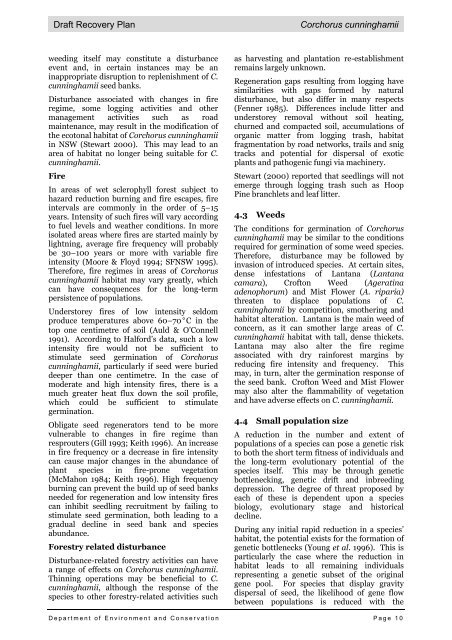Corchorus cunninghamii - Department of Environment and Climate ...
Corchorus cunninghamii - Department of Environment and Climate ...
Corchorus cunninghamii - Department of Environment and Climate ...
Create successful ePaper yourself
Turn your PDF publications into a flip-book with our unique Google optimized e-Paper software.
Draft Recovery Plan <strong>Corchorus</strong> <strong>cunninghamii</strong><br />
weeding itself may constitute a disturbance<br />
event <strong>and</strong>, in certain instances may be an<br />
inappropriate disruption to replenishment <strong>of</strong> C.<br />
<strong>cunninghamii</strong> seed banks.<br />
Disturbance associated with changes in fire<br />
regime, some logging activities <strong>and</strong> other<br />
management activities such as road<br />
maintenance, may result in the modification <strong>of</strong><br />
the ecotonal habitat <strong>of</strong> <strong>Corchorus</strong> <strong>cunninghamii</strong><br />
in NSW (Stewart 2000). This may lead to an<br />
area <strong>of</strong> habitat no longer being suitable for C.<br />
<strong>cunninghamii</strong>.<br />
Fire<br />
In areas <strong>of</strong> wet sclerophyll forest subject to<br />
hazard reduction burning <strong>and</strong> fire escapes, fire<br />
intervals are commonly in the order <strong>of</strong> 5–15<br />
years. Intensity <strong>of</strong> such fires will vary according<br />
to fuel levels <strong>and</strong> weather conditions. In more<br />
isolated areas where fires are started mainly by<br />
lightning, average fire frequency will probably<br />
be 30–100 years or more with variable fire<br />
intensity (Moore & Floyd 1994; SFNSW 1995).<br />
Therefore, fire regimes in areas <strong>of</strong> <strong>Corchorus</strong><br />
<strong>cunninghamii</strong> habitat may vary greatly, which<br />
can have consequences for the long-term<br />
persistence <strong>of</strong> populations.<br />
Understorey fires <strong>of</strong> low intensity seldom<br />
produce temperatures above 60–70°C in the<br />
top one centimetre <strong>of</strong> soil (Auld & O’Connell<br />
1991). According to Halford’s data, such a low<br />
intensity fire would not be sufficient to<br />
stimulate seed germination <strong>of</strong> <strong>Corchorus</strong><br />
<strong>cunninghamii</strong>, particularly if seed were buried<br />
deeper than one centimetre. In the case <strong>of</strong><br />
moderate <strong>and</strong> high intensity fires, there is a<br />
much greater heat flux down the soil pr<strong>of</strong>ile,<br />
which could be sufficient to stimulate<br />
germination.<br />
Obligate seed regenerators tend to be more<br />
vulnerable to changes in fire regime than<br />
resprouters (Gill 1993; Keith 1996). An increase<br />
in fire frequency or a decrease in fire intensity<br />
can cause major changes in the abundance <strong>of</strong><br />
plant species in fire-prone vegetation<br />
(McMahon 1984; Keith 1996). High frequency<br />
burning can prevent the build up <strong>of</strong> seed banks<br />
needed for regeneration <strong>and</strong> low intensity fires<br />
can inhibit seedling recruitment by failing to<br />
stimulate seed germination, both leading to a<br />
gradual decline in seed bank <strong>and</strong> species<br />
abundance.<br />
Forestry related disturbance<br />
Disturbance-related forestry activities can have<br />
a range <strong>of</strong> effects on <strong>Corchorus</strong> <strong>cunninghamii</strong>.<br />
Thinning operations may be beneficial to C.<br />
<strong>cunninghamii</strong>, although the response <strong>of</strong> the<br />
species to other forestry-related activities such<br />
as harvesting <strong>and</strong> plantation re-establishment<br />
remains largely unknown.<br />
Regeneration gaps resulting from logging have<br />
similarities with gaps formed by natural<br />
disturbance, but also differ in many respects<br />
(Fenner 1985). Differences include litter <strong>and</strong><br />
understorey removal without soil heating,<br />
churned <strong>and</strong> compacted soil, accumulations <strong>of</strong><br />
organic matter from logging trash, habitat<br />
fragmentation by road networks, trails <strong>and</strong> snig<br />
tracks <strong>and</strong> potential for dispersal <strong>of</strong> exotic<br />
plants <strong>and</strong> pathogenic fungi via machinery.<br />
Stewart (2000) reported that seedlings will not<br />
emerge through logging trash such as Hoop<br />
Pine branchlets <strong>and</strong> leaf litter.<br />
4.3 Weeds<br />
The conditions for germination <strong>of</strong> <strong>Corchorus</strong><br />
<strong>cunninghamii</strong> may be similar to the conditions<br />
required for germination <strong>of</strong> some weed species.<br />
Therefore, disturbance may be followed by<br />
invasion <strong>of</strong> introduced species. At certain sites,<br />
dense infestations <strong>of</strong> Lantana (Lantana<br />
camara), Cr<strong>of</strong>ton Weed (Ageratina<br />
adenophorum) <strong>and</strong> Mist Flower (A. riparia)<br />
threaten to displace populations <strong>of</strong> C.<br />
<strong>cunninghamii</strong> by competition, smothering <strong>and</strong><br />
habitat alteration. Lantana is the main weed <strong>of</strong><br />
concern, as it can smother large areas <strong>of</strong> C.<br />
<strong>cunninghamii</strong> habitat with tall, dense thickets.<br />
Lantana may also alter the fire regime<br />
associated with dry rainforest margins by<br />
reducing fire intensity <strong>and</strong> frequency. This<br />
may, in turn, alter the germination response <strong>of</strong><br />
the seed bank. Cr<strong>of</strong>ton Weed <strong>and</strong> Mist Flower<br />
may also alter the flammability <strong>of</strong> vegetation<br />
<strong>and</strong> have adverse effects on C. <strong>cunninghamii</strong>.<br />
4.4 Small population size<br />
A reduction in the number <strong>and</strong> extent <strong>of</strong><br />
populations <strong>of</strong> a species can pose a genetic risk<br />
to both the short term fitness <strong>of</strong> individuals <strong>and</strong><br />
the long-term evolutionary potential <strong>of</strong> the<br />
species itself. This may be through genetic<br />
bottlenecking, genetic drift <strong>and</strong> inbreeding<br />
depression. The degree <strong>of</strong> threat proposed by<br />
each <strong>of</strong> these is dependent upon a species<br />
biology, evolutionary stage <strong>and</strong> historical<br />
decline.<br />
During any initial rapid reduction in a species’<br />
habitat, the potential exists for the formation <strong>of</strong><br />
genetic bottlenecks (Young et al. 1996). This is<br />
particularly the case where the reduction in<br />
habitat leads to all remaining individuals<br />
representing a genetic subset <strong>of</strong> the original<br />
gene pool. For species that display gravity<br />
dispersal <strong>of</strong> seed, the likelihood <strong>of</strong> gene flow<br />
between populations is reduced with the<br />
<strong>Department</strong> <strong>of</strong> <strong>Environment</strong> <strong>and</strong> Conservation Page 10

















